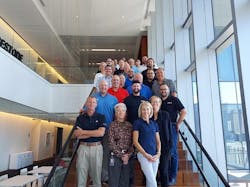Over the past four years a group of commercial tire dealers has set aside competition in the name of improving safety across their businesses, as well as the whole industry. At this year’s Safety Leadership Summit, the group included more than 40 representatives of tire dealerships and industry suppliers and leaders.
And while there are always safety concerns surrounding the handling, installation and removal of tires, tire dealers and their employees face other dangers, too.
One big danger comes from being behind the wheel of a vehicle. Tony Nickel, director of captive and special accounts for Federated Mutual Insurance, says distracted driving presents risks for all kinds of drivers. He cited a 2018 poll in which 55% of adults identified distracted driving as the top threat. Nine out of 10 of those same drivers admitted to talking on their cell phones while they drive.
Nickel pointed to the rising cost of automotive insurance claims in single fatality accidents. From 2003 to 2016, he says the average claim was $2.1 million. In two of those years – 2009 and 2016 – the average outpaced the norm, and was $2.8 million.
Since then, the average amounts have grown to $3.6 million, $4.4 million and $5.1 million in 2017, 2018 and 2019, respectively.
Nickel says those eye-popping figures should prompt businesses to review their company policies on employee driving. He says the rules need to be documented and specific, and he says requiring drivers to use hands-free technology in a vehicle is not enough. (Federated prohibits its employees from using a phone while driving – period.)
Nickel says a company policy needs to be communicated to employees, and “regularly re-communicated to employees.” He says having an employee read the policy when initially hired isn’t adequate. (His employer requires workers review it once a year.)
Also at play in the conversation around cell phone use behind the wheel is that many states have outlawed phone use unless it is hands free. Tire dealers need to be aware of those laws – and when they change – in their home state and in all regions where employees travel for business.
Tools, training offer safety
In addition to company rules and government regulations, safety improvements can come via updated tools and training resources.
Keith Jarman, president of AME International, and Don Tinker, who leads AME’s business development in North America, highlighted the proper use of composite cribbing, along with jack plates, to lift commercial trucks and equipment for tire service.
Tinker says “cribbing is not a one-size-fits all” tool, and AME can offer recommendations of what kind of cribbing is the best fit depending on what kind and size of service truck a tire dealership is using and outfitting. He says that kit must include jack plates.
AME also offers an assortment of lock out/tag out options to ensure drivers of vehicles in need of service don’t start driving the vehicle before the work is complete and the technician is safely away from the vehicle. These solutions can be helpful both at a service location, where someone behind a sales counter might return a vehicle’s keys to a driver a few minutes too early, and before the technician has removed all of the equipment from underneath a vehicle. But the lock out systems can also be used when on a roadside service call, though dealers acknowledged it can sometimes be difficult to take a driver’s key away. At a minimum, the key needs to be removed from the engine. (One dealer’s solution: using a zip tie to attach the key to a truck’s mirror during service.)
Though not always labeled a tool, a technician’s uniform also serves as part of the safety gear. John Luning, senior manager of Shoes for Crews, talked about the company’s slip-resistant footwear options. Shoes for Crews has multiple brands of shoes and boots available, and can accommodate all kinds of systems, no matter if a tire dealer pays for the full cost of its workers’ footwear, has an annual allowance for shoe expenses, or even if workers have to cover the full cost on their own.
Luning says 85% of workers’ compensation claims can be traced to employees falling on slick floors. The average cost of a slip or fall accident: $24,000.
Kevin Rohlwing, chief technical officer for the Tire Industry Association (TIA), says the association is in the midst of refreshing its Commercial Tire Service (CTS) training content. The updated 200-level Basic CTS class was released this year, and the 300-level Certified CTS is in progress now, with a release set for 2023. Rohlwing says the basic class covers the “how to,” while the 300-level “will focus on the why behind key procedures and practices.”
He expects the updates to include more footage from the field to demonstrate the primary points of servicing truck tire and wheel assemblies, with an increased emphasis on road service safety and how technicians can protect themselves when away from the shop.
“(We’re) hoping it will create a higher level of technician.”
Management buy-in
There can be hurdles to setting and enforcing these company policies. One representative from a tire dealership acknowledged her employer once had a policy that banned even hands-free phone use while driving – until the company learned “no one was following it” – including top leaders. The policy was dialed back because it seemed too risky to have it on the books knowing it wasn’t being enforced.
Sean Mcilhenney, vice president of risk control for Conner Strong & Buckelew, an insurance broker, says it’s imperative that managers who “have a clear understanding of the organization’s safety objectives and are fully invested in achieving those outcomes.”
Russ Devens, director of safety and risk management for McCarthy Tire Service Inc., suggests his fellow safety leaders at tire dealerships talk to their company leadership about how safety practices can offset the cost of insurance.
“The main driver is the cost of insurance (and) reducing claims to try to offset the cost of insurance, because every year the cost of insurance is increasing,” Devens says. “So the COO, the CEO is going to understand that.”
Devens says last year McCarthy Tire Service reduced its overall claim expenses. He says one of the biggest things that helped the tire dealership change its culture surrounding safety was ensuring managers at all levels were buying the message. He says that has been important to reinforce "a strong safety culture."




